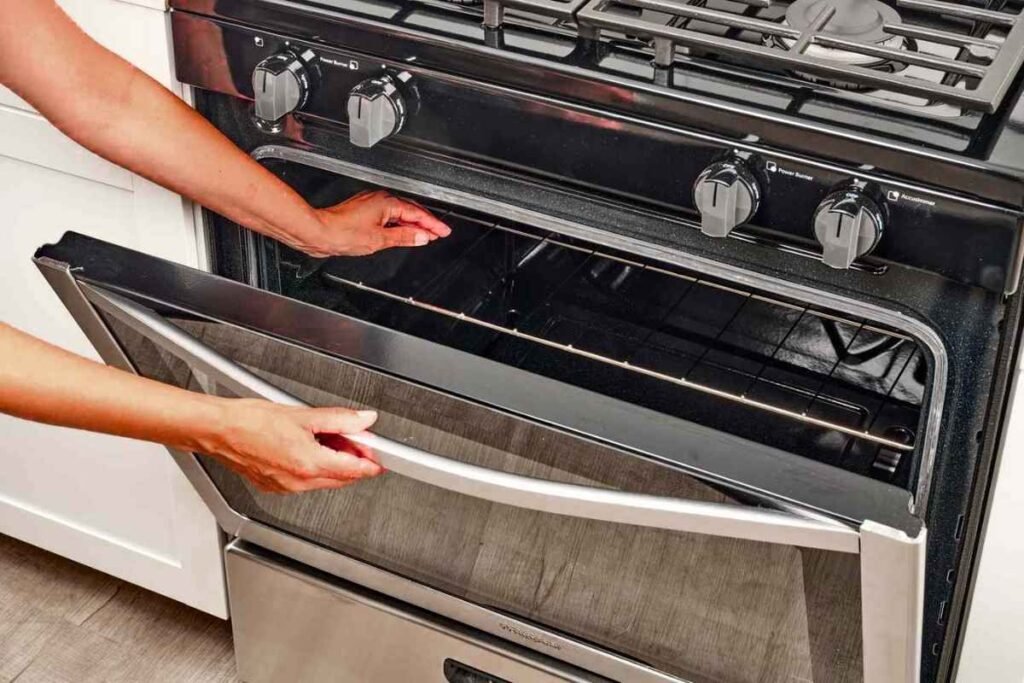That sinking feeling is all too familiar. You’ve prepped a beautiful Sunday roast or the kids’ birthday cake, you turn on the oven, but an hour later, it’s still cold. A non-heating oven is one of the most frustrating appliance failures, bringing your kitchen—and your meal plans—to a standstill.
Before you resign yourself to ordering takeaway, understand that this is a common issue with clear, identifiable causes. While some problems require a licensed technician, many can be diagnosed and even fixed with a few simple checks.
At Perfect Appliance Repair, we’ve serviced thousands of ovens across Sydney, from Westinghouse and Smeg to Bosch and Ilve. This guide distills our expert knowledge to help you safely identify the problem and get your oven working again.
Before You Inspect Your Oven in Your Sydney Home
CRITICAL WARNING: Your safety is paramount. Ovens are complex appliances connected to high-voltage electricity or gas lines. Before attempting any inspection, you must follow these steps:
- For Electric Ovens: Go to your home’s switchboard (fuse box). Locate the switch labelled “Oven” or “Stove” and flip it to the OFF position. This is the only way to ensure the appliance is completely disconnected from power.
- For Gas Ovens: Find the gas supply valve for your oven, usually located behind the unit or in a nearby cabinet. Turn the valve handle a quarter turn so it is perpendicular (at a right angle) to the pipe to shut off the gas supply. Adhering to NSW gas safety regulations is essential.
- Protect Yourself: Wear cut-resistant gloves to protect your hands from sharp metal edges inside the appliance chassis.
If you are ever unsure, stop immediately and call a professional.
3 Simple Fixes for Any Oven Type
These are the most common culprits and can often solve the problem in minutes, regardless of whether your oven is gas or electric.
1. Is It a Power or Settings Issue?
This seems obvious, but it accounts for a surprising number of service calls.
- Check the Display: Are the clock and other lights on the oven’s display panel lit up? If the display is completely blank, the oven isn’t receiving any power at all. Head to your circuit breaker (as described in the safety section) and check for a tripped switch. Reset it if necessary. If it trips again, you have an electrical fault that needs a licensed electrician.
- Is It in “Demo” or “Sabbath” Mode? Many modern ovens have a “Demo Mode” for showroom display or a “Sabbath Mode” which can disable heating functions. Look for an icon or text on the display. Your user manual will provide instructions on how to disable it—this often involves holding down a specific button for 3-5 seconds.
- Are the Dials Set Correctly? On non-digital models, ensure you have selected a cooking function (e.g., “Bake,” “Fan Forced”) and a temperature. A misaligned or worn-out function knob may feel like it’s in position but hasn’t actually engaged the heating circuit.
2. The Faulty Temperature Sensor
The temperature sensor is a thin, pencil-like metal rod, usually located inside the oven cavity near the top back corner. Its job is to read the internal temperature and tell the control board when to turn the heating elements or igniter on and off.
- Physical Inspection: Make sure the sensor isn’t touching the interior wall of the oven. If it is, it can give a false reading and fail to signal the oven to heat up. Gently bend it away from the wall.
- Advanced Check (for DIY enthusiasts): A faulty sensor won’t tell the oven it needs to start heating. After disconnecting power, you can unplug the sensor’s connection (usually accessible from the back panel) and test its resistance with a multimeter. A healthy sensor will typically have a resistance reading of around 1100 ohms at room temperature. A reading that is significantly off indicates the sensor needs replacement.
3. A Broken Oven Door
Your oven is designed to heat an enclosed, insulated space. If the door doesn’t create a perfect seal, it will struggle to reach temperature and, in some cases, a safety switch may prevent it from heating at all.
- Check the Seal: Inspect the gasket (the rubber or woven seal) around the inside edge of the door. Is it torn, brittle, or hanging loose? If so, heat is escaping, and the gasket needs to be replaced.
- Check the Hinges: Open the door halfway and see if it feels loose or wobbly. Broken or misaligned hinges will prevent the door from sealing flush against the oven body.
Still no heat? Don’t risk further damage. For reliable oven repairs across Sydney, book a certified Perfect Appliance Repair technician online or call us at 0414 146 227.
Troubleshooting Your Electric Oven in Sydney
If the universal checks didn’t work, the problem likely lies with a specific heating component. This is especially common with popular Sydney brands like Westinghouse, Chef, and Blanco.
The Bake Element Has Failed
This is the most common reason an electric oven won’t heat. The bake element is the primary heating source for most cooking functions and is located at the bottom of the oven.
- The Relationship: The bake element works in tandem with the broil element (top). If the oven broils but doesn’t bake, the bake element is almost certainly the culprit.
- Visual Inspection: With the power off, look closely at the bake element. Do you see any blisters, bubbles, cracks, or a clean break in the metal rod? These are definitive signs of a failed element.
- Function Test: If there are no visible signs, turn the power back on, set the oven to “Bake” at 180°C, and watch the element for a few minutes. A working element should glow a consistent, bright red-orange. If it doesn’t glow at all, or only parts of it glow, it needs to be replaced.
A Blown Thermal Fuse
The thermal fuse is a small but critical safety component. It’s designed to blow and cut off power to the heating elements if the oven overheats, preventing a fire.
- The Relationship: If the fuse has blown, the elements will not receive power, and the oven will not heat, even if the lights and display work.
- Diagnosis: This part is not visible from inside the oven. It’s usually located on the rear exterior panel. A professional technician can safely access and test the fuse with a multimeter for continuity. A blown fuse will show no continuity. Note: A blown thermal fuse often indicates an underlying problem, like a faulty thermostat or a blocked ventilation fan, which caused the overheating in the first place.
Troubleshooting Your Gas Oven in Sydney
Gas ovens, common in many Sydney homes and found in brands like Smeg and Fisher & Paykel, operate differently. If your gas oven won’t heat, the issue almost always involves the gas ignition system.
The Igniter is Weak or Broken
The gas oven igniter has a two-part job, and a failure in either part will result in no heat.
- The Relationship:
- It must get hot enough to ignite the gas. This is its most obvious function.
- It must draw enough electrical current to open the safety valve. This valve controls the flow of gas to the burner. A weak igniter may still glow, but if it doesn’t pull enough amps, the safety valve will not open, and no gas will be released.
- Diagnosis: Turn the oven on and look for the igniter’s glow (it’s often a small ceramic or metal bar near the main gas burner at the bottom of the oven).
- No Glow: The igniter is completely broken and needs replacement.
- Dull Red/Orange Glow: The igniter is weak. It may not be getting hot enough to ignite gas or, more likely, it’s not drawing enough current to open the safety valve. You may hear a “click” from the valve trying to open, but no whoosh of gas ignition.
- DIY Cleaning: Sometimes, grease and food debris can insulate the igniter. With the gas and power off, you can gently clean it with a toothbrush. If it still doesn’t work after cleaning, it’s time for a replacement.
The Gas Supply Line
A simple issue can sometimes be a closed or partially closed gas valve. The main shut-off valve for the appliance is typically located in the gas line behind your oven. Ensure the handle is parallel to the pipe, which indicates it is fully open. If you smell gas at any time, turn off the supply immediately, ventilate the area, and call a licensed gas fitter.
When to Call the Experts
Some faults require specialized tools, diagnostic expertise, and licensed qualifications to repair safely and effectively. If you’ve tried the steps above with no success, it’s time to call a professional.
- Faulty Selector Switch or Thermostat: These components control which element gets power and at what temperature.
- Malfunctioning Control Board: The oven’s electronic “brain” controls all its functions. If it fails, it can prevent the heating command from ever being sent.
- Wiring Issues: Burnt or loose internal wiring can interrupt power to the heating components.
Frequently Asked Questions
- Why is my oven not heating up but the stove works?
This is a very common scenario. It indicates that the appliance is receiving power (since the stove works), but the fault is isolated to the oven’s heating system. For an electric model, it points to a faulty bake element or thermal fuse. For a gas model, it almost always means a faulty igniter. - Can I replace my own oven heating element?
While it’s possible for those with good DIY skills, it can be tricky. You need to ensure you order the exact part for your model and handle the wiring safely. If you have any doubts, it’s always safer and more efficient to have a professional do it. - How much does it cost to fix an oven that won’t heat in Sydney?
The cost varies depending on the cause. A simple fix like a temperature sensor might be relatively inexpensive, while replacing a control board or a complex igniter will cost more. At Perfect Appliance Repair, we provide upfront, transparent pricing before any work begins, so there are no surprises. - Is it worth repairing an old oven?
It depends on the oven’s age, brand, and the cost of the repair. As a general rule, if the repair cost is less than half the price of a new, comparable oven, a repair is often the more economical choice. Our technicians can provide an honest assessment to help you decide.
Your Trusted Oven Repair Service in Sydney
Don’t let a cold oven disrupt your life. From the Northern Beaches to the Sutherland Shire, Perfect Appliance Repair is Sydney’s trusted choice for fast, reliable, and expert oven repairs. We specialize in all major brands and our technicians are fully licensed and insured, ensuring a safe and effective fix every time.
Get your kitchen’s centerpiece back in action.
Call us today at 0414 146 227 or Book Gas Oven Repair Service Online for a hassle-free repair.


